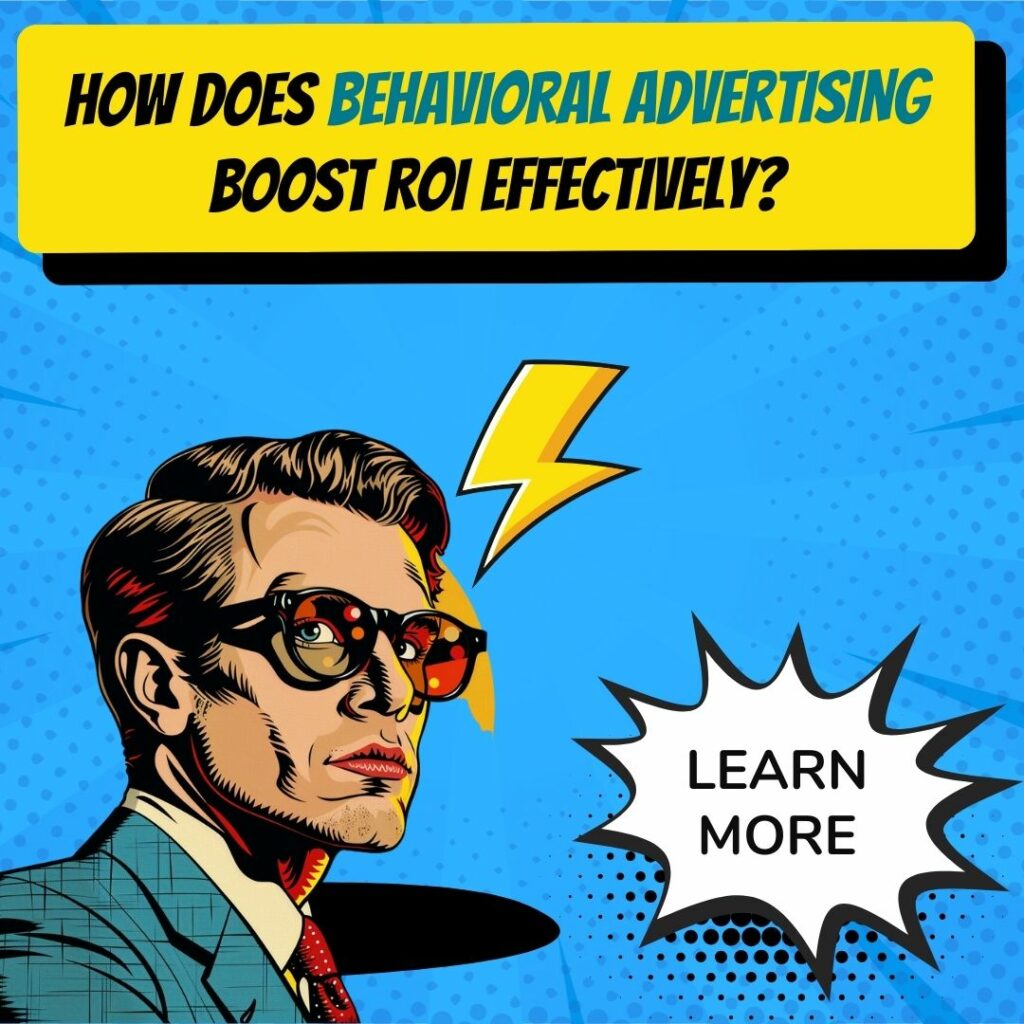Key Takeaways
✅ Psychographic Segmentation Increases Engagement: Creating ads that match your audience's values and lifestyles not only seems smart, but it can also lead to tangible benefits. Ads geared towards specific psychographic segments can bump up engagement by up to 20% and push click-through rates up by a whopping 50%. In real terms, that means more eyes on your products and potentially more money in your pocket.
✅ Behavioral Targeting Enhances Personalization: Tailoring ads to mirror a visitor's past behavior could be the game-changer your business needs for better targeting and personalization. The stats tell it all: targeted campaigns, especially retargeting efforts, can pull in click-through rates that are 10 times higher than your run-of-the-mill display ads. Now, who wouldn't want those kinds of results?
✅ Targeted Advertising Improves ROI Measurement: How do you know if your advertising budget is really working hard for you? Targeted advertising doesn't just aim at precision; it delivers on it. By drilling down into user behavior, you can track what's working and who your best customers are, leading to a more effective and profitable marketing strategy.

Introduction
Are your advertising dollars really hitting the mark, or are they just another drop in the digital ocean? In the quest for improving ROI, savvy businesses are turning to behavioral targeting and psychographic targeting to up their advertising game. But is this approach just a buzzword bonanza, or can it truly transform your ad spend into revenue?
In this article, we'll unlock the secrets of targeted advertising that's not just throwing shots in the dark but ones that are laser-focused on your potential customers' behaviors and lifestyle preferences. From understanding the nuts and bolts of targeted advertising strategies to harnessing the full potential of cutting-edge technologies, we promise to guide you through a treasure trove of actionable insights. Gear up to dive into the world of behavioral cues and psychological insights, where each click can teach you more about turning prospects into profits. Prepare yourself; by the end of this read, you'll have the blueprint to revamp your advertising approach for a stellar ROI.
Top Statistics
| Statistic | Insight |
|---|---|
| Behavioral targeting can increase click-through rates by up to 50%. | This impressive lift in engagement signifies how potent tailored content can be when knowing your audience. |
| Retargeting campaigns have a 10x higher CTR than standard display ads. | Retargeting keeps brands at the forefront of a consumer's mind, boosting the chances they'll circle back to make a purchase. |
| 66% of marketers struggle to unify data from disparate sources. | Unified data views are crucial for successful targeting, highlighting an area ripe for innovation and strategic focus. |
| Psychographic segmentation offers highly targeted user personas. | By honing in on specific consumer personalities, brands can speak directly to the heart of their customers' values and lifestyles. |
| Use of AI in behavioral targeting is increasingly popular. | Leveraging AI can help predict customer behavior, allowing companies to stay one step ahead in their marketing approaches. |
Understanding Behavioral Targeting and Psychographic Targeting
At the heart of modern marketing lies a crucial concept: the more you know about your audience, the better you can engage them. Behavioral targeting is a technique where online user activity is tracked, such as pages visited or searches made, to deliver advertisements tailored to their past behavior. On the other hand, psychographic targeting focuses more on the psychological attributes of consumers, such as values, beliefs, interests, and lifestyles, to create a more emotionally resonant advertising experience.
These strategies mark a shift away from traditional demographic targeting, which groups people by age, gender, income, and similar quantifiable traits. While demographics explain "who" the audience is, behavior and psychographics tell us "why" they make certain decisions. Understanding the subtle yet important differences between behavior and psychographics is vital because it helps advertisers tailor their messaging to the mindset and motivations of their audiences.
Benefits of Behavioral Targeting
With behavioral targeting, increased conversion rates become one of the prime objectives. When ads align with user behavior, they're more likely to strike a chord, leading to higher engagement and sales. Users also experience a sense of personalization, enhancing their overall online journey. Behind the scenes, advertisers gain valuable customer insights that further refine the targeting process. Additionally, ads that resonate with behaviors ensure better ROI, as marketing spend directs towards consumers more likely to convert, trimming the excess from bloated ad budgets.
Benefits of Psychographic Targeting
While behavioral targeting looks at the "what," psychographic targeting digs deeper into the "why" behind consumer choices. By understanding an individual's personal motivations and how they want to be seen by their peers—values, aspirations, and lifestyle choices—companies can craft messages that truly resonate. This approach often fosters stronger emotional connections, leading to increased brand affinity and loyalty. Moreover, when advertisements resonate with core values and interests, they meet the audience's needs, thus increasing the relevance and effectiveness of the advertising strategy.
Implementing Targeted Advertising Strategies
The path to targeted advertising requires a thoughtful approach. Choosing the right advertising platforms is just the starting point. Marketers must then create and optimize campaigns, ensuring they reach the intended audience segments. It's the continuous analysis of data and analytics that allows for refining targeting tactics, a fundamental step for improving campaign ROI. Fusing both behavioral and psychographic targeting can deliver the most potent results, combining insights into what actions consumers take with why they take them.
Measuring Success and Optimizing ROI
When the campaign is in full swing, key performance indicators (KPIs) come into play for measuring whether objectives are being met. Insights gleaned from behavioral data can highlight engagement patterns, while psychographic information can explain the resonance of content. Frequent A/B testing ensures an environment of continuous improvement, essential for staying competitive. Ultimately, the success of any campaign boils down to the ROI metrics, which balance expenditures against campaign effectiveness to inform strategic decisions.
Challenges and Future of Behavioral and Psychographic Targeting
In an age where privacy is paramount, behavioral and psychographic targeting face challenges. Advertisers must navigate privacy concerns and adjust to stringent data protection laws. Moreover, with ad blockers on the rise, marketers have to innovate constantly. Emerging technologies, like AI and machine learning, offer new ways to collect and process consumer information, preparing for a future where targeted advertising becomes even more sophisticated. As the landscape evolves, understanding and leveraging behavioral and psychographic insights will continue to be a linchpin in achieving superior marketing ROI.
AI Marketing Engineers Recommendation
Recommendation 1: Leverage Multi-Source Data for Comprehensive Behavioral Targeting: Combining data from various sources, such as web browsing habits, purchase history, and social media behavior, can paint a more accurate picture of consumer behavior. For instance, statistics show that integrating first-party with third-party data can lead to an increase in ad relevance by up to 30%. Employ a data management platform (DMP) to centralize and analyze this diverse data for sharper behavioral targeting, which is paramount in Improving ROI with refined and more personalized ad campaigns.
Recommendation 2: Integrate Psychographic Data with AI Analysis for Predictive Targeting: Keeping up with the latest trends where AI meets psychographics, use machine learning algorithms to predict future consumer patterns based on current psychographic data. This includes values, attitudes, interests, and lifestyles, not just demographics. AI can recognize nuanced patterns in large datasets that humans might miss. By aligning marketing messages with consumers' core motives and lifestyle preferences, companies have seen Improving ROI by as much as 20% through enhanced engagement and conversion rates.
Recommendation 3: Combining automation tools with Targeted Advertising: It's crucial to understand the significance of automation tools in Improving ROI with Targeted Advertising. Programs that automate bid management, for instance, ensure that you're investing precisely where the best returns are. Moreover, advertising platforms like Facebook's Lookalike Audiences and Google's Similar Audiences use your data to find new potential customers who match the profile of your current customers. Adopt these tools and watch your customer base – and your return on investment – grow significantly, sometimes by as much as 60% in lead generation efforts.
Relevant Links
- Hyper-Personalization in Korean Marketing: AI's Role in Tailored Shopping
- Navigating the Subtleties of Chinese Consumer Behavior: Trends for 2024
- Maximizing E-Commerce in South Korea with Top-Notch SEO
- Dive into German Digital Marketing: Choosing the Right Social Media Platforms
- Master the Intricacies of Psychographic Targeting in India
Conclusion
In the ever-evolving landscape of digital marketing, targeted advertising has emerged as a crucial tool in the marketer's arsenal for improving ROI significantly. By delving into behavioral targeting, we understand the vital role that tracking and analyzing user activity plays in crafting ads that resonate. Similarly, psychographic targeting uncovers the essence of why audience values, aspirations, and lifestyle choices can elevate advertising from noise to a symphony of relevance.
These strategies mark a departure from the broad brushstrokes of demographic targeting by painting a more nuanced picture of potential customers. The strategic use of these methods has been shown to increase conversion rates, enhance user experience, and forge stronger brand loyalty. In the journey toward maximum impact, integrating both targeting approaches allows brands to connect with their audience in a way that feels both personal and authentic.
Embracing these sophisticated forms of targeting, however, also brings forth challenges such as privacy concerns and staying ahead of the technological curve. As we look forward, marketers must navigate these waters with care and consideration, always keeping an eye on evolving regulations and user expectations. Nevertheless, the marriage of data, analytics, AI, and human insight holds great promise for refining targeting strategies and pushing ROI margins to new heights.
The call to action for marketers is clear: to continue experimenting, analyzing, and refining their targeted ad campaigns. By doing so, they can not only improve their bottom line but also build an advertising ecosystem rooted in understanding, respect, and value for the audience it serves. As we harness the full potential of behavioral and psychysical targeting, the future looks bright for those willing to lean into these transformative advertising strategies.
FAQs
Question 1: What is behavioral targeting?
Answer: Imagine this: you're online, and ads pop up that are just what you're into, like someone’s reading your mind. That’s behavioral targeting for you. It's all about gathering info on your web habits to show ads that are more your style.
Question 2: What is psychographic segmentation?
Answer: You know how you and your friends have different vibes, like some are artsy and others are all about adventure? Well, psychographic segmentation is where businesses sort these vibes into groups—interests, lifestyles, the works—so they hit the mark with their Google Ads.
Question 3: What are the benefits of audience segmentation?
Answer: Let's say you're getting bombarded with random ads—annoying, right? With audience segmentation, businesses cut through the noise. They tailor ads so that they chat to you personally, boosting how often people engage and click, which is a win-win for both of you.
Question 4: How does psychographic segmentation increase engagement rates?
Answer: So, you've got ads that actually get you. Like, they're about stuff you're genuinely into. That could make you twice as likely to click through because it feels like someone's speaking your language.
Question 5: What are some tools for gathering psychographic information?
Answer: Ever felt curious about what makes your customers tick? There's a toolbox out there for that. Surveys, analytics templates, even cool freebies like Similarweb can help you tune into your audience's frequency.
Question 6: How does behavioral segmentation improve ROI?
Answer: Think about ads that feel like they follow you around because they know what you like. That's behavioral segmentation, and it’s kind of like fishing where the fish are. You're more likely to catch a click (and a sale) because you're not just casting nets in the open ocean.
Question 7: How can businesses implement psychographic targeting?
Answer: It’s like setting up a dating profile for your customers. Get the lowdown on their personality, what they value, and how they live. Then, when you catch the eye of nature-loving customers, for example, show them gear that's all about being eco-friendly.
Question 8: What are some effective examples of behavioral segmentation?
Answer: Have you ever looked at a pair of shoes, skipped buying them and then seen those shoes in ads all over the web? That’s behavioral segmentation—stuff like sending you a sweet reminder of what you almost bought, or giving you the scoop on products that similar shoppers loved.
Question 9: How can market segmentation improve campaign catalyst performance?
Answer: Picture this: Rather than shouting a general message from the rooftops and hoping someone hears, segmentation is like sending a personalized postcard. It’s about crafting your story to match the audience, making them more likely to nod along and hit 'buy.
Question 10: What are the different methods of market segmentation?
Answer: If the market is a big party, segmentation is your way of mingling effectively. You’ve got demographics – are they young, old, rich, budget-conscious? Then there's the psychographics – are they free-spirits, ambitious go-getters? Geographics and behaviorals come next – where are they and what do they usually do?
Academic References
- HubSpot Blog. Behavioral Targeting and ROI.Retrieved from HubSpot Blog website. Behavioral targeting utilizes artificial intelligence to analyze a user's digital footprint, to enhance the relevance of advertisements. Despite the potential increase in campaign effectiveness and ROI, the approach demands a balance to prevent overwhelming the audience with advertisements and necessitates a deep understanding of the target market.
- The Yaffe Center. Psychographic Targeting Techniques.Retrieved from The Yaffe Center for Persuasive Communications. Psychographic targeting goes beyond demographics by aligning advertisements with the psychological attributes of consumers, such as their values, beliefs, and lifestyle choices—key to connecting with the right audience in a profound and meaningful way.
- DSpace@MIT. Targeted Online Advertising: Opportunities and Challenges.Retrieved from the DSpace@MIT repository. This thorough research delves into various online advertising strategies, including behavioral and psychographic targeting, assessing their effectiveness while also raising the important issue of consumer privacy rights.
- ResearchGate. Machine Learning and the Evolution of Targeted Advertising.Retrieved from the ResearchGate database. This paper examines the integration of machine learning in advertising, highlighting the technology's capability to sift through large datasets to tailor advertisements, subsequently influencing advertising precision and profitability. It also tackles the sensitive topic of ethical usage and privacy considerations.
- Liberty University. Enhancing Campaign Performance through Targeted Advertising. Retrieved from Liberty University's digital repository. The study underlines the strategic use of targeted advertising to pierce through the bombardment of commercial messages, emphasizing the necessity for not only precision in audience targeting but also the importance of maintaining message relevance and freshness to hold consumer attention.












